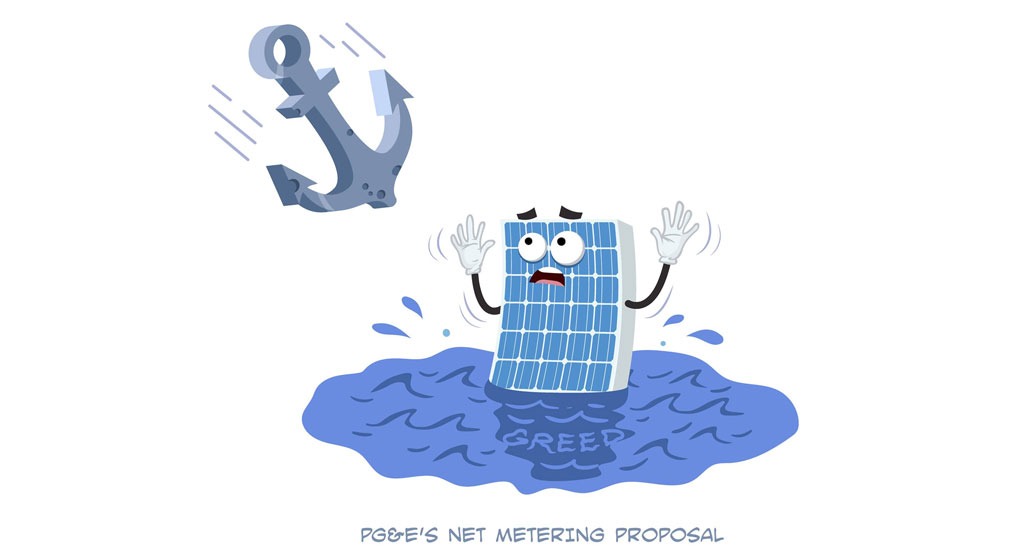Table of Contents
What NEM 3.0 Might Potentially Mean for Solar Homeowners in California
California, a sunny state in the West, is known for its local rooftop solar community. The solar industry is growing rapidly, and the number of homeowners switching to renewable energy is also on the rise. Popular policies like Net Metering (NEM) have helped solar become more affordable, which in turn encouraged millions of working-class and middle-income class families to install rooftop solar on their homes.
However, power-grabbing big utility companies are standing in the way of California’s progress with solar. Pacific Gas and Electric Company (PG&E), Southern California Edison (SCE), and San Diego Gas and Electric (SDG&E) have teamed up to call again for drastic reduction to the credit solar consumers will be receiving when selling excess energy to the grid. Furthermore, they are lobbying the California Public Utilities Commission (CPUC) to add a $65-90 monthly solar penalty fee to their energy bills.
We are in critical times now, and we need your help supporting rooftop solar and stopping the utility power grab. We have until November 20, 2022 to gather 100,000 signatures and send a message to Governor Gavin Newsom. It only takes less than a minute of your time to sign this petition. It is uncertain what the terms of the NEM 3.0 are, but we know it will not be as good as our current plan.
To help you understand what shake-up will be coming when the NEM 3.0 gets approved, we conducted research and compiled the different NEM changes amongst local utility companies.
As of November 2021, Sacramento Municipal Utilities District (SMUD) has approved to change a yearly true-up bill to a monthly true-up bill. Furthermore, February 28 is the last day customers can get grandfathered to the original NEM Program. The table below shows what changes have been made:

Hawaiian Electric Company
Our biggest fear is that our situation will be similar to Hawaii who also underwent some drastic changes when net metering switched 50% of what it previously was in 2016. It went from 100% trade of value in 2014 to 30% today. These changes also put customers’ installation in higher penetration areas on hold for 18 months (between 2014 and 2016). This delay was to determine whether the customer would qualify from the original NEM to what they have now. Today, Customers only get 10 cents when they send a kWh to the grid. This is despite the fact that utility companies charge for this same kWh. The minimal connection fee is $25 a month.

Pacific Gas & Electric
Most of you are familiar with the changes implemented in the area covered by PG&E. You can see in the table below how NEM 2.0 compares to the original NEM. You can expect that NEM 3.0 will be a much more extreme change. This is why we must sign the petition to help #SaveCaliforniaSolar. It is also urgent to install your solar system now (and tell your friends who have not yet gone solar to do as well) before NEM 2.0 goes away. NEM 2.0 is guaranteed for 20 years. This is a big deal when you sell your home because NEM is tied to the house, not to the homeowner who originally purchased it.
The way that they changed over from NEM 2.0 took place was that each family applying for solar had a reservation when they submitted the interconnection agreement upon permit submission. As long as the plan remains true, we have about a month from today’s publishing to get people locked in for the full 20 years on NEM 2.0. It is anticipated that the “grandfather period” will be far less than 20 years after mid-January. Currently, the new interconnection fee mandated with the changeover from NEM 1.0 to NEM 2.0 is covered for the customer by big solar companies. Big solar companies, like SunPower, would typically include permitting fees in their quotes as well. Smaller companies often have an added cost for both interconnection and permitting fees.

This is what is being requested by the big three utility companies:
- What could be 50-cent credit today may become 5 cents
- Minimal distribution fees of $10 monthly today could become $65-90 of minimal fees
If you want more information, we will be happy to provide you with a free consultation on a quick phone call or Zoom Chat.
Again, we are kindly requesting your help to Save California Solar by signing this petition. The power of the sun belongs to everyone. Let us keep California a solar state by protecting the policies that are driving its success.
Check out your solar options:

